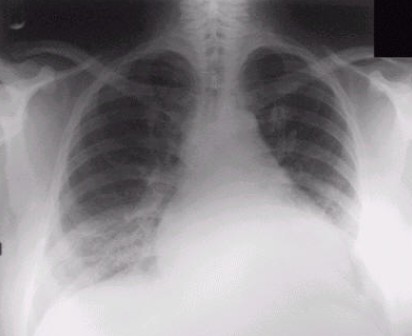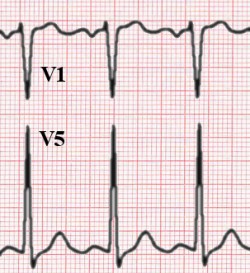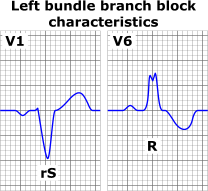Aortic stenosis resident survival guide: Difference between revisions
| Line 72: | Line 72: | ||
❑ Order a [[CXR]], look for: | ❑ Order a [[CXR]], look for: | ||
: ❑ [[Cardiomegaly]] | : ❑ [[Cardiomegaly]] | ||
[[File:LVH X ray.jpg|center|200px]] | |||
: ❑ [[calcific aortic valve disease|Valve calcification]] | : ❑ [[calcific aortic valve disease|Valve calcification]] | ||
: ❑ Dilatation of [[ascending aorta]] | : ❑ Dilatation of [[ascending aorta]] | ||
Revision as of 17:44, 19 March 2014
Editor-In-Chief: C. Michael Gibson, M.S., M.D. [1]; Associate Editor(s)-in-Chief: Alejandro Lemor, M.D. [2]
| Aortic Stenosis Resident Survival Guide Microchapters |
|---|
| Overview |
| Causes |
| Diagnosis |
| Treatment |
| Do's |
| Don'ts |
Overview
Aortic stenosis is the progressive narrowing of the diameter of the aortic valve (normal valve area is 3 - 4 cm²) and symptoms are caused by a decrease in stroke volume that leads to decrease perfusion to peripheral tissues, however, symptoms normally appear when the stenosis is ≤ 1.0 cm². The most common etiology of aortic stenosis is calcific aortic valve disease. The management will depend if the patient is symptomatic or asymptomatic. Surgical intervention is the treatment of choice for patients with symptomatic aortic stenosis.
Causes
Life Threatening Causes
Life-threatening causes include conditions which may result in death or permanent disability within 24 hours if left untreated.
Common Causes
Diagnosis
Shown below is an algorithm summarizing the diagnosis approach to aortic stenosis based on the 2014 AHA/ACC Guideline for the Management of Patients With Valvular Heart Disease: Executive Summary [1][2]
Abbreviations: LVH: Left ventricle hypertrophy; CXR: Chest x-ray; ECG: Electrocardiogram; LBBB: Left bundle branch block; AF: Atrial fibrillation; AVR: Aortic valve replacement; VHD: Valve heart disease; TAVR: Transcatheter aortic valve replacement
Characterize the symptoms: ❑ Most patients are asymptomatic ❑ Dyspnea on exertion ❑ Exertional dizziness ❑ Exertional angina ❑ Syncope ❑ Chest pain ❑ Palpitations | |||||||||||||||||||||||||||||||||||||||||||||||||
Inquire about past medical history: ❑ Previously healthy ❑ Cardiac disease: ❑ Rheumatic fever ❑ Pulmonary disease | |||||||||||||||||||||||||||||||||||||||||||||||||
Examine the patient: ❑ Heart rate
{{#ev:youtube|MJg257pyt4I|200}} | |||||||||||||||||||||||||||||||||||||||||||||||||
Order imaging and adjuvant studies: ❑ Order an echocardiography, assess:
❑ Order a CXR, look for: 
❑ Order a ECG, look for:



| |||||||||||||||||||||||||||||||||||||||||||||||||
Interpret results from echo | |||||||||||||||||||||||||||||||||||||||||||||||||
Mild to moderate stenosis (Stage B) Mild: ❑ Valve area 1.5-2.5 cm² ❑ Pressure gradient ≤ 25 mmHg Moderate: ❑ Valve area 1.0-1.5 cm² ❑ Pressure gradient 25-40 mmHg | Severe stenosis ❑ Valve area ≤ 1.0 cm² ❑ Pressure gradient ≥ 40 mmHg | ||||||||||||||||||||||||||||||||||||||||||||||||
Perform a periodic echocardiogram (Class I; Level of Evidence: B) ❑ Every 3 -5 years for mild stenosis ❑ Every 1 - 2 years for moderate stenosis | Patient asymptomatic (Stage C) | Patient symptomatic (Stage D) | |||||||||||||||||||||||||||||||||||||||||||||||
❑ Control hypertension (Class I; Level of Evidence: B) | Normal LVEF (Stage C1) | LVEF < 50% (Stage C2) | High gradient (ΔP ≥ 40 mmHg) (Stage D1) | ||||||||||||||||||||||||||||||||||||||||||||||
Perform a periodic echocardiogram every 6 - 12 months (Class I; Level of Evidence: B) | Schedule for AVR (Class I; Level of Evidence: A) | Schedule for AVR (Class IIa; Level of Evidence: B-C) | |||||||||||||||||||||||||||||||||||||||||||||||
If aortic velocity ≥ 5 m/s or decrease in exercise tolerance: ❑ Schedule for AVR (Class IIa; Level of Evidence: B) | |||||||||||||||||||||||||||||||||||||||||||||||||
Choice of Intervention
Shown below is an algorithm summarizing the choice of the intervention to aortic stenosis based on the 2014 AHA/ACC Guideline for the Management of Patients With Valvular Heart Disease: Executive Summary [1]
STS: Society of Thoracic Surgeons
Patient scheduled for AVR | |||||||||||||||||||||||||||||||||
| High risk[3]
❑ STS Score[4] > 10 ❑ EuroScore[5] > 20 | Low to moderate risk[3]
❑ STS Score[4] < 10 ❑ EuroScore[5] < 20 | ||||||||||||||||||||||||||||||||
❑ A multidisciplinary group of physicians with expertise in VHD, cardiac imaging, interventional cardiology, cardiac anesthesia, and cardiac surgery should decide intervention (Surgical AVR or TAVR) (Class I; Level of Evidence: C) ❑ Schedule for TAVR (Class IIa; Level of Evidence: B)[1] [6] | ❑ Schedule for surgical AVR (Class I; Level of Evidence: A) | ||||||||||||||||||||||||||||||||
Type of Valve and Discharge Anticoagulation Therapy
❑ Determine the age of the patient ❑ Check for contraindications for anticoagulation | |||||||||||||||||||||||||||||||||
❑ Patients ≤ 70 years old (Class IIa; Level of Evidence: B), and ❑ No contraindication for anticoagulation | ❑ Patients ≥ 70 years old (Class IIa; Level of Evidence: B), or ❑ Patients with anticoagulant therapy contraindications (Class I; Level of Evidence: C) | ||||||||||||||||||||||||||||||||
| Mechanical Prosthesis | Bioprosthesis | ||||||||||||||||||||||||||||||||
Patient with risk factors | Patient without risk factors | ||||||||||||||||||||||||||||||||
❑ Either a bioprosthetic or mechanical valve is reasonable in patients between 60 and 70 years of age. (Class IIa; Level of Evidence: B).
Do's
❑ Give ACE inhibitors to control hypertension in patients with asymptomatic aortic stenosis. [7]
❑ Exercise testing in asymptomatic patients with AS may be considered to elicit exercise-induced symptoms and abnormal blood pressure responses (Class IIb; Level of Evidence: B).
❑ Dobutamine stress echocardiography is reasonable to evaluate patients with low-flow/low-gradient AS and LV dysfunction (Stage D3) (Class IIa; Level of Evidence: B)
❑ Aortic balloon valvotomy might be reasonable as a bridge to surgery in hemodynamically unstable adult patients with AS who are at high risk for AVR or cannot be performed because of serious comorbid conditions.(Class IIb; Level of Evidence: C).
Don'ts
❑ Do not perform a stress test in a symptomatic patient with stage D aortic stenosis (Class III; Level of Evidence: B).
❑ Do not give statins to prevent hemodynamic progression in patients with mild to moderate calcific aortic valve disease (Class III; Level of Evidence: A).
❑ TAVR is not recommended in patients in whom existing comorbidities would preclude the expected benefit from correction of AS (Class III; Level of Evidence: B)
❑ Do not give vasodilators to patients with severe AS as they may cause severe hypotension.
❑ Endocarditis prophylaxis is not indicated in patients with AR. [8]
References
- ↑ 1.0 1.1 1.2 "2014 AHA/ACC Guideline for the Management of Patients With Valvular Heart Disease: Executive Summary". Retrieved 4 March 2014.
- ↑ Bonow, R. O.; Carabello, B. A.; Chatterjee, K.; de Leon, A. C.; Faxon, D. P.; Freed, M. D.; Gaasch, W. H.; Lytle, B. W.; Nishimura, R. A.; O'Gara, P. T.; O'Rourke, R. A.; Otto, C. M.; Shah, P. M.; Shanewise, J. S. (2008). "2008 Focused Update Incorporated Into the ACC/AHA 2006 Guidelines for the Management of Patients With Valvular Heart Disease: A Report of the American College of Cardiology/American Heart Association Task Force on Practice Guidelines (Writing Committee to Revise the 1998 Guidelines for the Management of Patients With Valvular Heart Disease): Endorsed by the Society of Cardiovascular Anesthesiologists, Society for Cardiovascular Angiography and Interventions, and Society of Thoracic Surgeons". Circulation. 118 (15): e523–e661. doi:10.1161/CIRCULATIONAHA.108.190748. ISSN 0009-7322.
- ↑ 3.0 3.1 Ben-Dor, I.; Pichard, A. D.; Gonzalez, M. A.; Weissman, G.; Li, Y.; Goldstein, S. A.; Okubagzi, P.; Syed, A. I.; Maluenda, G.; Collins, S. D.; Delhaye, C.; Wakabayashi, K.; Gaglia, M. A.; Torguson, R.; Xue, Z.; Satler, L. F.; Suddath, W. O.; Kent, K. M.; Lindsay, J.; Waksman, R. (2010). "Correlates and Causes of Death in Patients With Severe Symptomatic Aortic Stenosis Who Are Not Eligible to Participate in a Clinical Trial of Transcatheter Aortic Valve Implantation". Circulation. 122 (11_suppl_1): S37–S42. doi:10.1161/CIRCULATIONAHA.109.926873. ISSN 0009-7322.
- ↑ 4.0 4.1 "Online STS Risk Calculator". Retrieved 7 March 2014.
- ↑ 5.0 5.1 "http://www.euroscore.org/calc.html". Retrieved 7 March 2014. External link in
|title=(help) - ↑ Smith, Craig R.; Leon, Martin B.; Mack, Michael J.; Miller, D. Craig; Moses, Jeffrey W.; Svensson, Lars G.; Tuzcu, E. Murat; Webb, John G.; Fontana, Gregory P.; Makkar, Raj R.; Williams, Mathew; Dewey, Todd; Kapadia, Samir; Babaliaros, Vasilis; Thourani, Vinod H.; Corso, Paul; Pichard, Augusto D.; Bavaria, Joseph E.; Herrmann, Howard C.; Akin, Jodi J.; Anderson, William N.; Wang, Duolao; Pocock, Stuart J. (2011). "Transcatheter versus Surgical Aortic-Valve Replacement in High-Risk Patients". New England Journal of Medicine. 364 (23): 2187–2198. doi:10.1056/NEJMoa1103510. ISSN 0028-4793.
- ↑ Chambers, J. (2005). "The left ventricle in aortic stenosis: evidence for the use of ACE inhibitors". Heart. 92 (3): 420–423. doi:10.1136/hrt.2005.074112. ISSN 1355-6037.
- ↑ Bonow, RO.; Carabello, BA.; Chatterjee, K.; de Leon, AC.; Faxon, DP.; Freed, MD.; Gaasch, WH.; Lytle, BW.; Nishimura, RA. (2008). "2008 Focused update incorporated into the ACC/AHA 2006 guidelines for the management of patients with valvular heart disease: a report of the American College of Cardiology/American Heart Association Task Force on Practice Guidelines (Writing Committee to Revise the 1998 Guidelines for the Management of Patients With Valvular Heart Disease): endorsed by the Society of Cardiovascular Anesthesiologists, Society for Cardiovascular Angiography and Interventions, and Society of Thoracic Surgeons". Circulation. 118 (15): e523–661. doi:10.1161/CIRCULATIONAHA.108.190748. PMID 18820172. Unknown parameter
|month=ignored (help)